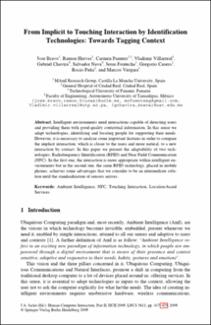| dc.contributor.author | Villarreal, Vladimir | |
| dc.contributor.author | Hervás, Ramón | |
| dc.contributor.author | Bravo, José | |
| dc.contributor.author | Fuentes, Carmen | |
| dc.contributor.author | Chavira, Gabriel | |
| dc.contributor.author | Nava, Salvador | |
| dc.contributor.author | Fontecha, Jesús | |
| dc.contributor.author | Casero, Gregorio | |
| dc.contributor.author | Peña, Rocio | |
| dc.contributor.author | Vergara, Marcos | |
| dc.date.accessioned | 2018-05-09T18:28:07Z | |
| dc.date.available | 2018-05-09T18:28:07Z | |
| dc.date.issued | 07/19/2009 | |
| dc.date.issued | 07/19/2009 | |
| dc.identifier.uri | http://ridda2.utp.ac.pa/handle/123456789/4754 | |
| dc.description | Intelligent environments need interactions capable of detecting users and providing them with good-quality contextual information. In this sense we adapt technologies, identifying and locating people for supporting their needs. However, it is necessary to analyze some important features in order to compare the implicit interaction, which is closer to the users and more natural, to a new interaction by contact. In this paper we present the adaptability of two technologies; Radiofrequency Identification (RFID) and Near Field Communication (NFC). In the first one, the interaction is more appropriate within intelligent environments but in the second one, the same RFID technology, placed in mobile phones, achieves some advantages that we consider to be an intermediate solution until the standardization of sensors arrives. | en_US |
| dc.description.abstract | Intelligent environments need interactions capable of detecting users and providing them with good-quality contextual information. In this sense we adapt technologies, identifying and locating people for supporting their needs. However, it is necessary to analyze some important features in order to compare the implicit interaction, which is closer to the users and more natural, to a new interaction by contact. In this paper we present the adaptability of two technologies; Radiofrequency Identification (RFID) and Near Field Communication (NFC). In the first one, the interaction is more appropriate within intelligent environments but in the second one, the same RFID technology, placed in mobile phones, achieves some advantages that we consider to be an intermediate solution until the standardization of sensors arrives. | en_US |
| dc.format | application/pdf | |
| dc.language | eng | |
| dc.language.iso | eng | en_US |
| dc.rights | info:eu-repo/semantics/restrictedAccess | |
| dc.subject | Ambient Intelligence | en_US |
| dc.subject | NFC | en_US |
| dc.subject | Touching Interaction | en_US |
| dc.subject | Location-based Services | en_US |
| dc.subject | Ambient Intelligence | |
| dc.subject | NFC | |
| dc.subject | Touching Interaction | |
| dc.subject | Location-based Services | |
| dc.title | From implicit to touching interaction by identification technologies: Towards tagging context | en_US |
| dc.type | info:eu-repo/semantics/article | |
| dc.type | info:eu-repo/semantics/publishedVersion | |
